by Rod
Elser and Jane Carroll
(click on photos to enlarge image)
SILVER OPEN SALTS AT THE VICTORIA & ALBERT MUSEUM
(part 2)
This is 'part 2' of an article dealing with the
collection of silver open salts of the The Victoria and Albert
Museum -or just the "V&A" as it is more commonly known- located
on Cromwell Road in London and established in 1852. Part 1
of this article was published in January 2009 Newsletter and is
available
clicking here.
The V&A collection of salts spanned a period of manufacture of
nearly 500 years -dating from the early 1500's to a very
contemporary silver salt made in 1979- and its policy allows
photographs (without the use of tripod equipment). Other photos
are published from The V&A website with the kind permission of
the museum (these photos are noted with © Victoria and Albert
Museum, London).
The descriptions noted are those provided by the museum with
only minor edits. Where dimensions were given they have been
noted here as well. For lack of a better methodology, the salts
have been organized by age. Obviously we are very appreciative
of the V&A's policy on photography so we can share these open
salts with fellow collectors and we would certainly encourage
anyone visiting London to view these items in person as well as
the many other lovely items in the museum's collections.
Sheffield plate salt with blue glass liner
c. 1775; Sheffield, England; H 4.5 cm., L 8.1 cm., W
6.35 cm.
This is a Sheffield plate salt cellar. This salt
cellar dates from about 1790. At this time pierced
oval-shaped cellars in the Neo-classical style were
common. They had four ball-and-claw feet and colored
glass liners. The plater used a fly press to stamp
the pierced decoration. Fly presses contained a
shaped punch that pressed out patterns in
silver-plated copper or Sheffield plate.
Silversmiths traditionally used the fretsaw to cut
patterns out of silver sheet. However, sawing plated
objects tended to disturb the thin layer of silver
and expose the edge of the copper beneath the silver
plate. As the fly press pierced the plate metal, it
also ingeniously dragged the top layer of silver
over the edge of the copper. It joined it to the
layer of silver on the underside, cleverly
concealing the cut copper edge. .
© Victoria and Albert Museum, London
|
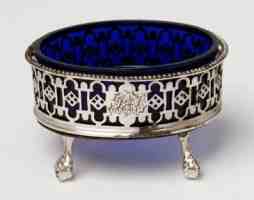 |
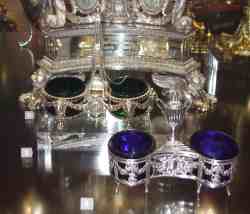 |
Silver-gilt double salt with green glass
liners (in back)
mark of Marc-Etienne Janety, Paris, France; 1778-79.
The Neoclassical style is self-consciously
monumental. The dominant feature of this salt is its
obelisk handle. Architects such as Venetian Giovanni
Battista Piranesi and the Parisian Jean-Laurent Le
Geay frequently sketched commemorative plinths and
obelisks among the ruins in Rome. Silversmiths
acquired their designs and added elements of them to
their repertoires. (in front) Silver double salt
with blue glass liners; mark of Marc-Etienne Janety,
Paris, France; 1782-83. Among archaeological finds,
the shapes of vases, ewers and urns could be adapted
most easily as containers for use on the dinning or
dressing table. In this salt, however, the urn
merely serves as a handle, adds symmetry and hints
at the object’s purpose as a container.
|
Pair of Sheffield plate salts with blue glass
liners
c. 1780; Sheffield, England; H 5.08 cm., L 7.8 cm.,
W 6.1 cm.
In the late 18th century, pierced oval shaped
cellars on four ball and claw feet and with colored
glass liners in the style of the neo-classical
revival were common.
© Victoria and Albert Museum, London
|
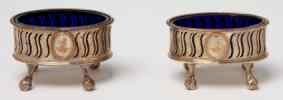
|
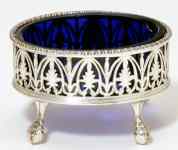 |
Sheffield plate salt with blue glass liner
c. 1780; Sheffield, England; H 5.08 cm., L 8.3 cm.,
W 6.3 cm.
This is a Sheffield plate salt cellar. Smaller salt
cellars that stood near individual plates developed
in the early 17th century. They replaced the
inconvenient central standing salt. This salt cellar
dates from about 1790. At this time pierced
oval-shaped cellars in the Neo-classical style were
common. They typically had four ball-and-claw feet
and colored glass liners.
© Victoria and Albert Museum, London
|
Sheffield plate salt with blue glass liner
c. 1780; Sheffield, England; H 7.61 cm., W 10.66 cm.
This piece, made in the period 1750-1800, has the
pierced oval shape in the Neo-classical style with a
large round foot and colored glass liner.
© Victoria and Albert Museum, London
|
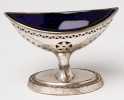
|
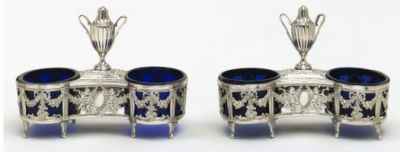 |
Silver and glass salt
1782-1783; designed by Marc-Etienne Janety; Paris,
France; H 10.6 cm., L 14.7 cm., W 7.7 cm.
Among archaeological finds, vases, ewers and urns
could be adapted most easily as containers for use
on the dining or dressing table. In this salt
cellar, however, the urn merely serves as a handle,
added for symmetry and to hint at the object's
purpose as a container. Blue glass added an
attractive decorative element to silver from the
1770s, especially in France and England. It also
served a practical purpose as unlike silver, it was
not corroded by salt, was easier to keep clean, and
was cheaper to replace
© Victoria and Albert Museum, London
|
Sheffield plate salt with blue glass liner
1785-1790; Sheffield, England; H 5.58 cm., L 9.1
cm., W 5.8 cm.
This salt cellar dates from about 1790. At this time
pierced oval-shaped cellars in the Neo-classical
style were common. They had four ball-and-claw feet
and colored glass liners.
© Victoria and Albert Museum, London
|
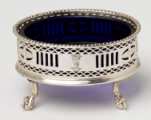 |
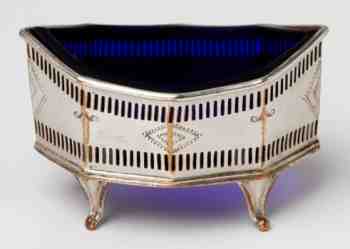 |
Sheffield plate salt with blue glass liner
1785-1790; Sheffield, England;
H 5.58 cm., L 9.1 cm., W 5.8 cm.
© Victoria and Albert Museum, London
|
Sheffield plate salt with blue glass liner
c. 1785; Sheffield, England;
H 6.6 cm., L 10.9 cm., W 6.7 cm.
© Victoria and Albert Museum, London
|
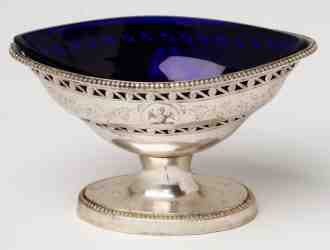 |
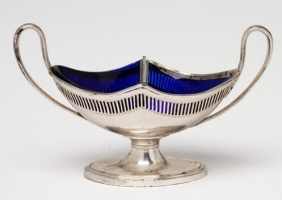 |
Sheffield plate salt with blue glass liner
c. 1790; Sheffield, England; H 3 ¾ in., L 6 1/8 in.
In the late 18th century, pierced oval shaped
cellars with liners in a neo-classical revival style
were common.
This example has pierced sides with arcading and
unusually, two removable, blue glass liners.
© Victoria and Albert Museum, London
|
Sheffield plate salt with blue glass liner
c. 1790; Sheffield, England.
This salt cellar dates from about 1790.
At this time pierced oval-shaped cellars in the
Neo-classical style were common.
© Victoria and Albert Museum, London
|
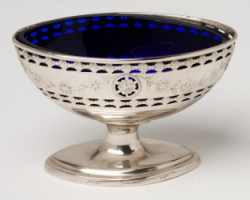 |
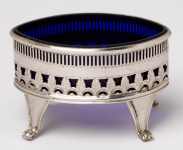 |
Sheffield plate salt with blue glass liner
c. 1790; Sheffield, England; H 5.39 cm., L 8.89 cm.
This salt cellar dates from about 1790. At this time
pierced oval-shaped cellars in the Neo-classical
style were common.
© Victoria and Albert Museum, London
|
Sheffield plate salt
late 18th century; Sheffield, England; H 5.39 cm., D
7.62 cm.
The inconvenience of a central standing salt
receptacle encouraged the development in the early
17th century of much smaller salt cellars which were
set near individual place settings. This
English-made round bowl-shaped salt cellar is one of
a pair. It has a frilled lip and sits on three
cabriole legs Sheffield plate was discovered in
about 1742 by Thomas Boulsover, a Sheffield cutler.
Boulsover’s discovery was simply that copper and
silver in unequal amounts, when fused expanded
together indefinitely at uniform rate under
mechanical pressure. The introduction of Sheffield
plate revolutionized the plating industry for it
offered an effective, relatively cheap, supremely
versatile and durable plating technique which could
convincingly imitate the surface appearance of solid
silver. The industry this material created
flourished for about 100 years until superseded by
electroplating
© Victoria and Albert Museum, London
|
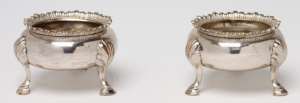 |
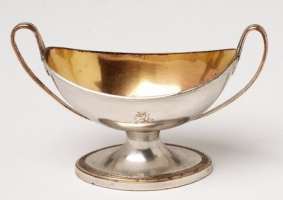 |
Sheffield plate salt;
late 18th century; Sheffield, England;
H 3.2 in., L 5.1 in; W 2.3 in.
In the late 18th century, boat shaped cellars on a
spreading foot in the style of the neo-classical
revival were common.
When there was no glass liner supplied, as with this
example, the interior was gilded to prevent the salt
corroding the silver surface.
© Victoria and Albert Museum, London
|
Silver salt, inside layer spun and gilt, cast foot
and branches, beaded rim
1825-1826; designed by John Bridge; London, England;
Dia. 3.25., H 2.63 in.
This salt cellar shows the impact of naturalism on
19th-century design, which reached its height in the
1850s. The love of nature had romantic and religious
resonances, John Ruskin commenting that 'all noble
ornamentation is the expression of man's delight in
God's work'. Inspiration from the natural world was
also one of the key features of the Rococo Revival.
© Victoria and Albert Museum, London
|
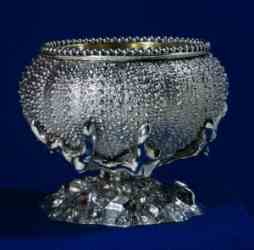 |
 |
Sheffield plate salt with unusual cranberry-glass
liners
late 18th century; Sheffield, England; H 2 in., L 3
in., W 2 3/8 in.
This small salt cellar would have stood close to an
individual plate. These smaller containers developed
in the early 17th century to replace the less
convenient central standing salt. This piece, made
in the period 1750-1800, has the pierced oval shape,
four ball and claw feet and colored glass liner
typical of salts in the Neo-classical style. ©
Victoria and Albert Museum, London
|
Sheffield plate salt with blue glass liner
late 18th century; Sheffield, England; H 1 ¾ in., L
3 ½ .
© Victoria and Albert Museum, London
|
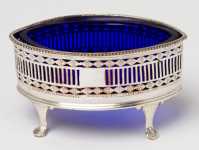 |
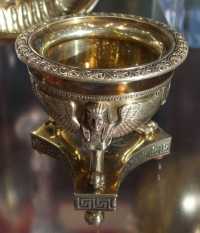 |
Silver-gilt salt cellar
mark of Digby Scott and Benjamin Smith, London,
1806-7.
The design of this salt can be attributed to the
work of Jean Jacques Boileau. He came to England
from France in 1787 as a mural painter for the
Prince Regent’s new home of Carlton Place.
Boileau’s silver designs balance plain silver with a
small range of classical or Egyptian ornament
combined in simple, almost geometric forms. The
sphinxes and triform base are typical of his work.
The Royal Goldsmiths Rundell, Bridge and Rundell
began producing silver based on Boileau designs from
about 1803 and a group of drawings attributed to the
designer can be seen in the Print Room of the V & A.
Scott and Smith, the makers of this salt, were
regular suppliers to Rundells.
|
Pair of Sheffield plate salt cellars
c. 1810; Sheffield, England; H 2 1/16 in., W 4 ¼ in.
© Victoria and Albert Museum, London
|
 |
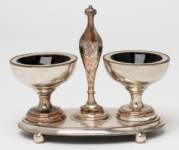 |
Sheffield plate salt
early 19th century; probably Paris, France; H 5 in.,
L 6 in., W 3 1/8 in.
By the late 18th century, single or sometimes double
salt cellars, distributed at regular intervals down
the length of the table, were common.
These salt cellars were a popular in Sheffield
plate, like this example, which has a central,
upright handle decorated with foliage and palmettes.
© Victoria and Albert Museum, London
|
Silver salt cellar with interior gilt
(on left) mark of Paul Storr and ‘390’ stamped;
London, 1815-16.
(on right) mark of David and Robert Hennell; London,
1803-4; it is engraved with the crest of Lowther
within the garter and surmounted by a coronet.
(Photographer’s Note: The handles, which extend to
become the base are coiled snakes!)
|
 |
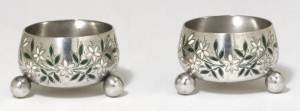 |
Pair of silver and enamel open salts
1874-1875 (hallmarked); Thomas Smiley, London,
England.
H 1 1/6 in., D 2 in.
At grand dinners individual silver, electroplate or
glass salt cellars with spoons were placed above
every place setting. It was just as correct to offer
one salt cellar between two, which would still
enable guests to have easy access to the condiment.
Salt cellars could be purchased in a huge number of
styles, from Gothic to Neo-classical, to match the
consumer's taste or the fashion of the moment. The
general form and the ball feet of this salt look
back to the early 19th century
© Victoria and Albert Museum, London
|
Silver salt cellar made by an unidentified maker
Western India (Cutch)
around 1885.
Cutch silver, from a small island in Northwestern
India, with its emphasis on floral scrolls in
tightly grouped areas of high relief, became
fashionable among Europeans during the second half
of the 19th-century. According to the museum, they
probably acquired this piece from Liberty and Co.
who advertised this pattern as ‘Kutch Work’ in their
Yuletide Catalogue of around 1890.
|
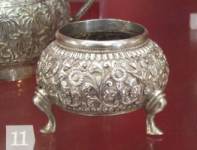 |
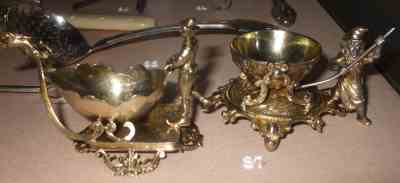 |
Two silver salt cellars;
Germany, late 19th century
figural shapes, almost novelty style.
|
Silver salt cellar
Germany, late 19th century: figural with design of a
barrel maker
|
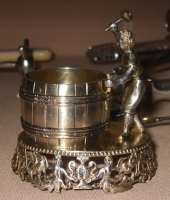 |
Part 1 of this article was published in January
2009 Newsletter -
click here
|
Rod Elser and Jane Carroll
Rod is Editor of the National Newsletter of the Open
Salt Collectors, an organization based in the United
States.
His wife Jane, a native of England, is ever patient with
his "obsession" (her words) with open salts.
- 2009 -
Information about Open Salt Collectors is available at
their web site:
www.opensalts.info
|
|
|
 ASSOCIATION OF SMALL COLLECTORS OF ANTIQUE SILVER
ASSOCIATION OF SMALL COLLECTORS OF ANTIQUE SILVER























